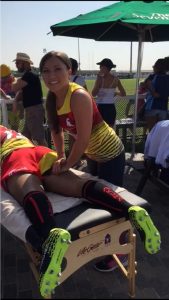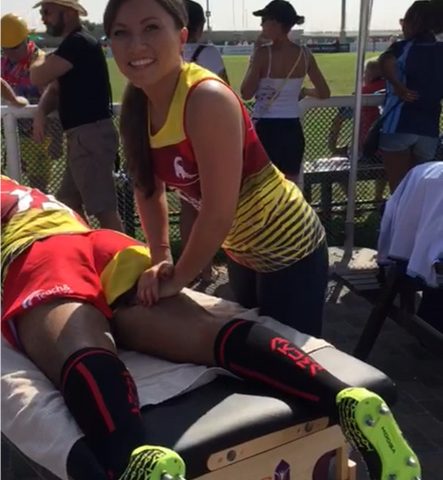Benefits of Pre and Post Event sports massage for athletes

What is Graston Technique?
December 19, 2016
Think Before You Dope…
January 8, 2017 As an athlete or sportsperson it is very important to implement pre event and post event sports massage into your training program and preparation.
As an athlete or sportsperson it is very important to implement pre event and post event sports massage into your training program and preparation.
Whether you are a professional athlete or an amateur training at a high level of intensity and looking to improve your conditioning and enhance your performance, ideally you should already be including deep tissue massage as part of your weekly training regime as a preventative measure before leaving it too late and using it as injury rehabilitation.
Pre Event Massage
A pre event massage is usually not more than 10 or 15 minutes in duration and performed on the day of the event. Sports psychology is important at this time, whilst providing the massage, the therapist should be talking to the athlete in an encouraging and positive way. Telling athletes that their muscles feel good, and that they seem well prepared for competition can be as encouraging as the massage. If athletes seem nervous, the therapist can encourage them to talk to help dissipate the nervousness but should try to discourage them from talking negatively about themselves or the competition. Understanding the athletes is important. Athletes prepare for their events in different ways. Some like to sit quietly to prepare for competition; others have a lot of nervous energy and are talkative and active right before competing. The therapist should observe what each athlete’s needs are and not interfere in the process of getting ready.
The therapist wants the athlete to leave the massage table feeling good and prepared to compete, not lethargic or about to fall asleep. The pace of the massage should be stimulating and brisk. The trainer wants to bring warmth to the superficial tissue of the body and increase blood flow to the deeper muscles. A good approach is to run the joints through their ranges of motion to increase lubrication and then to stretch the muscles gently.
The general rule of pre event massage is that the closer the massage is to the time of competition, the less invasive it should be. The therapist never wants to take the chance of injuring or pulling a muscle on an athlete right before the competition. Applying deep tissue massage or vigorously stretching an athlete right before the competition is often too much of a change for the body to handle. In most pre event massages little oil or lubricant is applied to the body because it can clog the pores in the skin, making it difficult for the athlete to sweat.
The therapist wants to target the muscles used in the athlete’s sport.
A pre event massage should include these techniques:
- Friction to create heat to warm up the superficial tissue
- Compression to increase blood flow to the muscles
- Tapotement to stimulate the muscles
- Range of motion of the joints to increase or decrease stiffness
- Gentle stretching to prepare muscles for the warm-up
The goal is always to have the athlete leave the table feeling prepared for athletic competition. Pre event massage is for stimulation and inspiration for the athlete.
Inter-competition massage
Sports massage during the event or competition is helpful to quickly restore energy levels, balance psycho-emotional state, prevent injury, cramps, spasms, and relieve pain in case of micro-trauma or chronic problems. Massage session can vary approximately from 1 – 2 minutes to 15 – 20 minutes.
Post Event Massage
Post event massage is administered immediately after the event or competition. Post-event massage is done to decrease muscle soreness and/or cramping and to facilitate a faster return to training after an athletic event.
A post-event massage is designed to aid the athlete in recovering from the activity; flush out the lactic acid buildup, reduce post-exercise soreness; and re-establish range of motion and blood flow to tight muscles. It also can give the athlete a big psychological lift. Before administering the massage, allow the athlete to cool down and rehydrate. Conduct a brief interview to ensure that he or the is coherent and rational. I like to ask if the athlete is really sore. I also ask the athlete to tell me if he or she experiences any discomfort during the massage, so I can adjust my technique; post-event massage should never be too painful to the athlete.
An on site post-event massage is administered for approximately 10 to 15 minutes. A typical post-event leg routine might consist of compressive effleurage for calming the nervous system and pushing fluid; pettrisage for easing tension in the muscle; compression for spreading muscle fibres and restoring blood flow; broadening strokes to lengthen tight muscles; and compressive effleurage as a finishing stroke to soothe. Following the massage, therapeutic stretching can be administered to relieve muscle tension and restore range of motion.
During the massage, the therapist should watch for cuts; scrapes; bruises; blisters; and mild strains and sprains, and have them treated appropriately by the medical team.
Often, an athlete will experience muscle cramps during the massage. If it is a single muscle, I like to use reciprocal inhibition technique to relieve the cramping; however, when an athlete experiences cramping in more than one muscle group, it might be a sign of dehydration. Medical attention should be sought to ensure it does not become a serious medical problem.
An athlete may feel light-headed and dizzy; watch as the first few steps are taken away from the massage table. Sometimes, cramping may occur as the athlete’s muscles are reactivating.
An effective post-event massage helps an athlete feel better immediately following a competition. Along with the great psychological boost, it allows the athlete to recover more quickly. Most athletes look forward to seeing massage therapists at an event because they know they will enjoy their well-deserved post-event massage treatment.
Sports massage should be continued weekly after a competition to replenish the athletes musculoskeletal system and therefore begin to prepare them for any further events and prevent injury.




